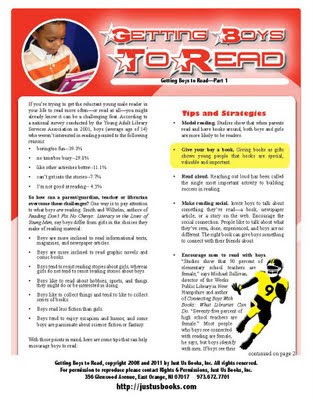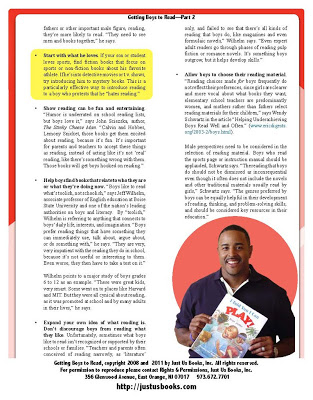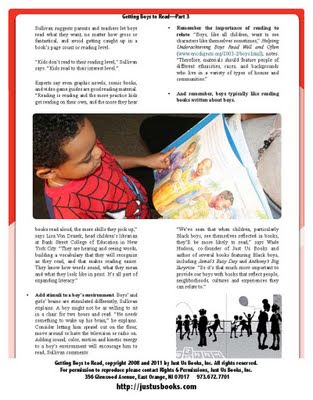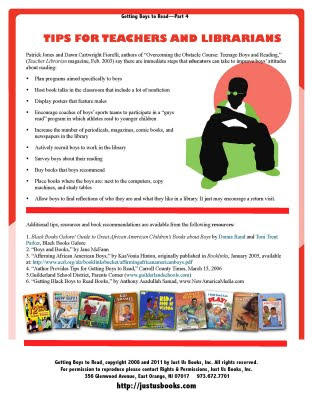Books
Getting Boys to Read—Part One

If you’re trying to get the reluctant young male reader in your life to read more often—or read at all—you might already know it can be a challenging feat. According to a national survey conducted by the Young Adult Library Services Association in 2001, boys (average age of 14) who weren’t interested in reading pointed to the following reasons:
With those points in mind, here are some tips that can help encourage boys to read:
Tips and Strategies
- Getting Boys To Read
Getting Boys to Read—Part OneIf you’re trying to get the reluctant young male reader in your life to read more often—or read at all—you might already know it can be a challenging feat. According to a national survey conducted by the Young Adult...
- Getting Boys To Read: Parts One — Four
Getting Boys to Read—Part One If you’re trying to get the reluctant young male reader in your life to read more often—or read at all—you might already know it can be a challenging feat. According to a national survey conducted by the Young...
- Getting Boys To Read—part Four
(continued—Part Four Getting Boys to Read) TIPS FOR TEACHERS AND LIBRARIANS Patrick Jones and Dawn Cartwright Fiorelli, authors of “Overcoming the Obstacle Course: Teenage Boys and Reading,” (Teacher Librarian magazine, Feb. 2003) say there...
- Getting Boys To Read—part Three
(continued—Part Three Getting Boys to Read) Sullivan suggests parents and teachers let boys read what they want, no matter how gross or fantastical, and avoid getting caught up in a book’s page count or reading level. “Kids don’t read to...
- A Conversation With Author Omar Tyree
@font-face { font-family: "Arial"; }@font-face { font-family: "Verdana"; }@font-face { font-family: "Cambria"; }@font-face { font-family: "Tahoma"; }@font-face { font-family: "Arial Narrow"; }@font-face { font-family: "Bookman Old Style";...
Books
Getting Boys to Read: Parts One — Four
Getting Boys to Read—Part One

If you’re trying to get the reluctant young male reader in your life to read more often—or read at all—you might already know it can be a challenging feat. According to a national survey conducted by the Young Adult Library Services Association in 2001, boys (average age of 14) who weren’t interested in reading pointed to the following reasons:
- boring/no fun--39.3%
- no time/too busy--29.8%
- like other activities better--11.1%
- can’t get into the stories--7.7%
- I’m not good at reading-- 4.3%
So how can a parent/guardian, teacher or librarian overcome these challenges? One way is to pay attention to what boys are reading. Smith and Wilhelm, authors of Reading Don’t Fix No Chevys: Literacy in the Lives of Young Men, say boys differ from girls in the choices they make of reading material:
- Boys are more inclined to read informational texts,magazines, and newspaper articles.
- Boys are more inclined to read graphic novels and comic books.
- Boys tend to resist reading stories about girls, whereas girls do not tend to resist reading stories about boys.
- Boys like to read about hobbies, sports, and things they might do or be interested in doing.
- Boys like to collect things and tend to like to collect series of books.
- Boys read less fiction than girls.
- Boys tend to enjoy escapism and humor, and some boys are passionate about science fiction or fantasy.
With those points in mind, here are some tips that can help encourage boys to read:
Tips and Strategies
- Model reading. Studies show that when parents read and have books around, both boys and girls are more likely to be readers.
- Give your boy a book. Giving books as gifts shows young people that books are special, valuable and important.
- Read aloud. Reaching out loud has been called the single most important activity to building success in reading.
- Make reading social. Invite boys to talk about something they’ve read—a book, newspaper article, or a story on the web. Encourage the social connection. People like to talk about what they’ve seen, done, experienced, and boys are no different. The right book can give boys something to connect with their friends about.
- Encourage men to read with boys.
“Studies show that 90 percent of elementary school teachers are female,” says Michael Sullivan, director of the Weeks Public Library in New Hampshire and author of Connecting Boys With Books: What Libraries Can Do. “Seventy-five percent of high school teachers are female.” Most people who boys see connected with reading are female, he says, but boys identify with men. (to be continued tomorrow in Part Two)
Getting Boys to Read, copyright 2008 and 2011 by Just Us Books, Inc. All rights reserved.
For permission to reproduce please contact Rights & Permissions, Just Us Book Inc.
e-mail: [email protected] http://justusbooks.com 973.672.7701
(continued from page one: Getting Boys to Read—Part Two)

For permission to reproduce please contact Rights & Permissions, Just Us Book Inc.
e-mail: [email protected] http://justusbooks.com 973.672.7701
(continued from page one: Getting Boys to Read—Part Two)

If boys see their fathers or other important male figure, reading, they’re more likely to read. “They need to see men and books together,” he says.
• Start with what he loves. If your son or student loves sports, find fiction books that focus on sports or non-fiction books about his favorite athlete. If he’s into detective movies or t.v. shows, try introducing him to mystery books. This is a particularly effective way to introduce reading to a boy who protests that he “hates reading.”
• Show reading can be fun and entertaining. “Humor is underrated on school reading lists, but boys love it,” says John Sciezska, author, The Stinky Cheese Man. “Calvin and Hobbes, Lemony Snicket, those books get them excited about reading, because it’s fun. It’s important for parents and teachers to accept these things as reading, instead of acting like it’s not ‘real’ reading, like there’s something wrong with them. Those books will get boys hooked on reading.”
• Help boys find books that relate to who they are or what they’re doing now. “Boys like to read what’s toolish, not schoolish,” says Jeff Wilhelm, associate professor of English education at Boise State University and one of the nation’s leading authorities on boys and literacy. By “toolish,” Wilhelm is referring to anything that connects to boys’ daily life, interests, and imagination. “Boys prefer reading things that have something they can immediately use, talk about, argue about, or do something with,” he says. “They are very, very impatient with the reading they do in school, because it’s not useful or interesting to them. Even worse, they then have to take a test on it.”
Wilhelm points to a major study of boys grades 6 to 12 as an example. “These were great kids, very smart. Some went on to places like Harvard and MIT. But they were all cynical about reading, as it was promoted at school and by many adults in their lives,” he says.
• Expand your own idea of what reading is. Don’t discourage boys from reading what they like. Unfortunately, sometimes what boys like to read isn’t recognized or supported by their schools or families. “Teachers and parents often conceived of reading narrowly, as ‘literature’ only, and failed to see that there’s all kinds of reading that boys do, like magazines and even formulaic novels,” Wilhelm says. “Even expert adult readers go through phases of reading pulp fiction or romance novels. It’s something boys outgrow, but it helps develop skills.”
• Allow boys to choose their reading material. “Reading choices made for boys frequently do not reflect their preferences, since girls are clearer and more vocal about what books they want, elementary school teachers are predominantly women, and mothers rather than fathers select reading materials for their children,” says Wendy Schwartz in the article “Helping Underachieving Boys Read Well and Often.” (www.ericdigests. org/2003-2/boys.html).
Male perspectives need to be considered in the selection of reading material. Boys who read the sports page or instruction manual should be applauded, Schwartz says. “The reading that boys do should not be dismissed as inconsequential even though it often does not include the novels and other traditional materials usually read by girls,” Schwartz says. “The genres preferred by boys can be equally helpful in their development of reading, thinking, and problem-solving skills, and should be considered key resources in their education.”
• Start with what he loves. If your son or student loves sports, find fiction books that focus on sports or non-fiction books about his favorite athlete. If he’s into detective movies or t.v. shows, try introducing him to mystery books. This is a particularly effective way to introduce reading to a boy who protests that he “hates reading.”
• Show reading can be fun and entertaining. “Humor is underrated on school reading lists, but boys love it,” says John Sciezska, author, The Stinky Cheese Man. “Calvin and Hobbes, Lemony Snicket, those books get them excited about reading, because it’s fun. It’s important for parents and teachers to accept these things as reading, instead of acting like it’s not ‘real’ reading, like there’s something wrong with them. Those books will get boys hooked on reading.”
• Help boys find books that relate to who they are or what they’re doing now. “Boys like to read what’s toolish, not schoolish,” says Jeff Wilhelm, associate professor of English education at Boise State University and one of the nation’s leading authorities on boys and literacy. By “toolish,” Wilhelm is referring to anything that connects to boys’ daily life, interests, and imagination. “Boys prefer reading things that have something they can immediately use, talk about, argue about, or do something with,” he says. “They are very, very impatient with the reading they do in school, because it’s not useful or interesting to them. Even worse, they then have to take a test on it.”
Wilhelm points to a major study of boys grades 6 to 12 as an example. “These were great kids, very smart. Some went on to places like Harvard and MIT. But they were all cynical about reading, as it was promoted at school and by many adults in their lives,” he says.
• Expand your own idea of what reading is. Don’t discourage boys from reading what they like. Unfortunately, sometimes what boys like to read isn’t recognized or supported by their schools or families. “Teachers and parents often conceived of reading narrowly, as ‘literature’ only, and failed to see that there’s all kinds of reading that boys do, like magazines and even formulaic novels,” Wilhelm says. “Even expert adult readers go through phases of reading pulp fiction or romance novels. It’s something boys outgrow, but it helps develop skills.”
• Allow boys to choose their reading material. “Reading choices made for boys frequently do not reflect their preferences, since girls are clearer and more vocal about what books they want, elementary school teachers are predominantly women, and mothers rather than fathers select reading materials for their children,” says Wendy Schwartz in the article “Helping Underachieving Boys Read Well and Often.” (www.ericdigests. org/2003-2/boys.html).
Male perspectives need to be considered in the selection of reading material. Boys who read the sports page or instruction manual should be applauded, Schwartz says. “The reading that boys do should not be dismissed as inconsequential even though it often does not include the novels and other traditional materials usually read by girls,” Schwartz says. “The genres preferred by boys can be equally helpful in their development of reading, thinking, and problem-solving skills, and should be considered key resources in their education.”
Getting Boys to Read, copyright 2008 and 2011 by Just Us Books, Inc. All rights reserved.
For permission to reproduce please contact Rights & Permissions, Just Us Book Inc.
e-mail: [email protected] http://justusbooks.com 973.672.7701
(continued Getting Boys to Read—Part Three)

Getting Boys to Read, copyright 2008 and 2011 by Just Us Books, Inc. All rights reserved. For permission to reproduce please contact Rights & Permissions, Just Us Books, Inc. 356 Glenwood Avenue, East Orange, NJ 07017 973.672.7701
http://justusbooks.com
(continued Getting Boys to Read—Part Four)

Additional tips, resources and book recommendations are available from the following resources:
For permission to reproduce please contact Rights & Permissions, Just Us Book Inc.
e-mail: [email protected] http://justusbooks.com 973.672.7701
(continued Getting Boys to Read—Part Three)

Sullivan suggests parents and teachers let boys read what they want, no matter how gross or fantastical, and avoid getting caught up in a book’s page count or reading level. “Kids don’t read to their reading level,” Sullivan says. “Kids read to their interest level.”
Experts say even graphic novels, comic books, and video game guides are good reading material. “Reading is reading and the more practice kids get reading on their own, and the more they hear books read aloud, the more skills they pick up,” says Lisa Von Drasek, head children’s librarian at Bank Street College of Education in New York City. “They are hearing and seeing words, building a vocabulary that they will recognize as they read, and that makes reading easier. They know how words sound, what they mean and what they look like in print. It’s all part of expanding literacy.”
Experts say even graphic novels, comic books, and video game guides are good reading material. “Reading is reading and the more practice kids get reading on their own, and the more they hear books read aloud, the more skills they pick up,” says Lisa Von Drasek, head children’s librarian at Bank Street College of Education in New York City. “They are hearing and seeing words, building a vocabulary that they will recognize as they read, and that makes reading easier. They know how words sound, what they mean and what they look like in print. It’s all part of expanding literacy.”
- Add stimuli to a boy’s environment. Boys’ and girls’ brains are stimulated differently, Sullivan explains. A boy might not be as willing to sit in a chair for two hours and read. “He needs something to wake up his brain,” he explains. Consider letting him sprawl out on the floor, move around or have the television or radio on. Adding sound, color, motion and kinetic energy to a boy’s environment will encourage him to read, Sullivan comments
- Remember the importance of reading to relate. “Boys, like all children, want to see characters like themselves sometimes,” Helping Underachieving Boys Read Well and Often (www.ericdigests.org/2003-2/boys.html), notes. “Therefore, materials should feature people of different ethnicities, races, and backgrounds who live in a variety of types of homes and communities.”
- And remember, boys typically like reading books written about boys. “We’ve seen that when children, particularly Black boys, see themselves reflected in books, they’ll be more likely to read,” says Wade Hudson, co-founder of Just Us Books and author of several books featuring Black boys, including Jamal’s Busy Day and Anthony’s Big Surprise. “So it’s that much more important to provide our boys with books that reflect people, neighborhoods, cultures and experiences they can relate to.”
Getting Boys to Read, copyright 2008 and 2011 by Just Us Books, Inc. All rights reserved. For permission to reproduce please contact Rights & Permissions, Just Us Books, Inc. 356 Glenwood Avenue, East Orange, NJ 07017 973.672.7701
http://justusbooks.com
(continued Getting Boys to Read—Part Four)
TIPS FOR TEACHERS AND LIBRARIANS

Patrick Jones and Dawn Cartwright Fiorelli, authors of “Overcoming the Obstacle Course: Teenage Boys and Reading,” (Teacher Librarian magazine, Feb. 2003) say there are immediate steps that educators can take to improve boys’ attitudes about reading:
- Plan programs aimed specifically to boys
- Host book talks in the classroom that include a lot of nonfiction
- Display posters that feature males
- Encourage coaches of boys’ sports teams to participate in a “guys read” program in which athletes read to younger children
- Increase the number of periodicals, magazines, comic books, and newspapers in the library
- Actively recruit boys to work in the library
- Survey boys about their reading
- Buy books that boys recommend
- Place books where the boys are: next to the computers, copy machines, and study tables
- Allow boys to find reflections of who they are and what they like in a library. It just may encourage a return visit.
Additional tips, resources and book recommendations are available from the following resources:
- Black Books Galore! Guide to Great African American Children’s Books about Boys by Donna Rand and Toni Trent Parker, Black Books Galore
- “Boys and Books,” by Jane McFann
- “Affirming African American Boys,” by KaaVonia Hinton, originally published in Booklinks, January 2005, available at: http://www.acrl.org/ala/booklinksbucket/affirmingafricanamericanboys.pdf
- “Author Provides Tips for Getting Boys to Read,” Carroll County Times, March 15, 2006
- Guilderland School District, Parents Corner (www.guilderlandschools.com)
- “Getting Black Boys to Read Books,” by Anthony Asadullah Samad, www.NewAmericaMedia.com
Getting Boys to Read, copyright 2008 and 2011 by Just Us Books, Inc. All rights reserved. For permission to reproduce please contact Rights & Permissions, Just Us Books, Inc. 356 Glenwood Avenue, East Orange, NJ 07017 973.672.7701
http://justusbooks.com
http://justusbooks.com
- Getting Boys To Read
Getting Boys to Read—Part OneIf you’re trying to get the reluctant young male reader in your life to read more often—or read at all—you might already know it can be a challenging feat. According to a national survey conducted by the Young Adult...
- Getting Boys To Read: Parts One — Four
Getting Boys to Read—Part One If you’re trying to get the reluctant young male reader in your life to read more often—or read at all—you might already know it can be a challenging feat. According to a national survey conducted by the Young...
- Getting Boys To Read—part Four
(continued—Part Four Getting Boys to Read) TIPS FOR TEACHERS AND LIBRARIANS Patrick Jones and Dawn Cartwright Fiorelli, authors of “Overcoming the Obstacle Course: Teenage Boys and Reading,” (Teacher Librarian magazine, Feb. 2003) say there...
- Getting Boys To Read—part Three
(continued—Part Three Getting Boys to Read) Sullivan suggests parents and teachers let boys read what they want, no matter how gross or fantastical, and avoid getting caught up in a book’s page count or reading level. “Kids don’t read to...
- A Conversation With Author Omar Tyree
@font-face { font-family: "Arial"; }@font-face { font-family: "Verdana"; }@font-face { font-family: "Cambria"; }@font-face { font-family: "Tahoma"; }@font-face { font-family: "Arial Narrow"; }@font-face { font-family: "Bookman Old Style";...
